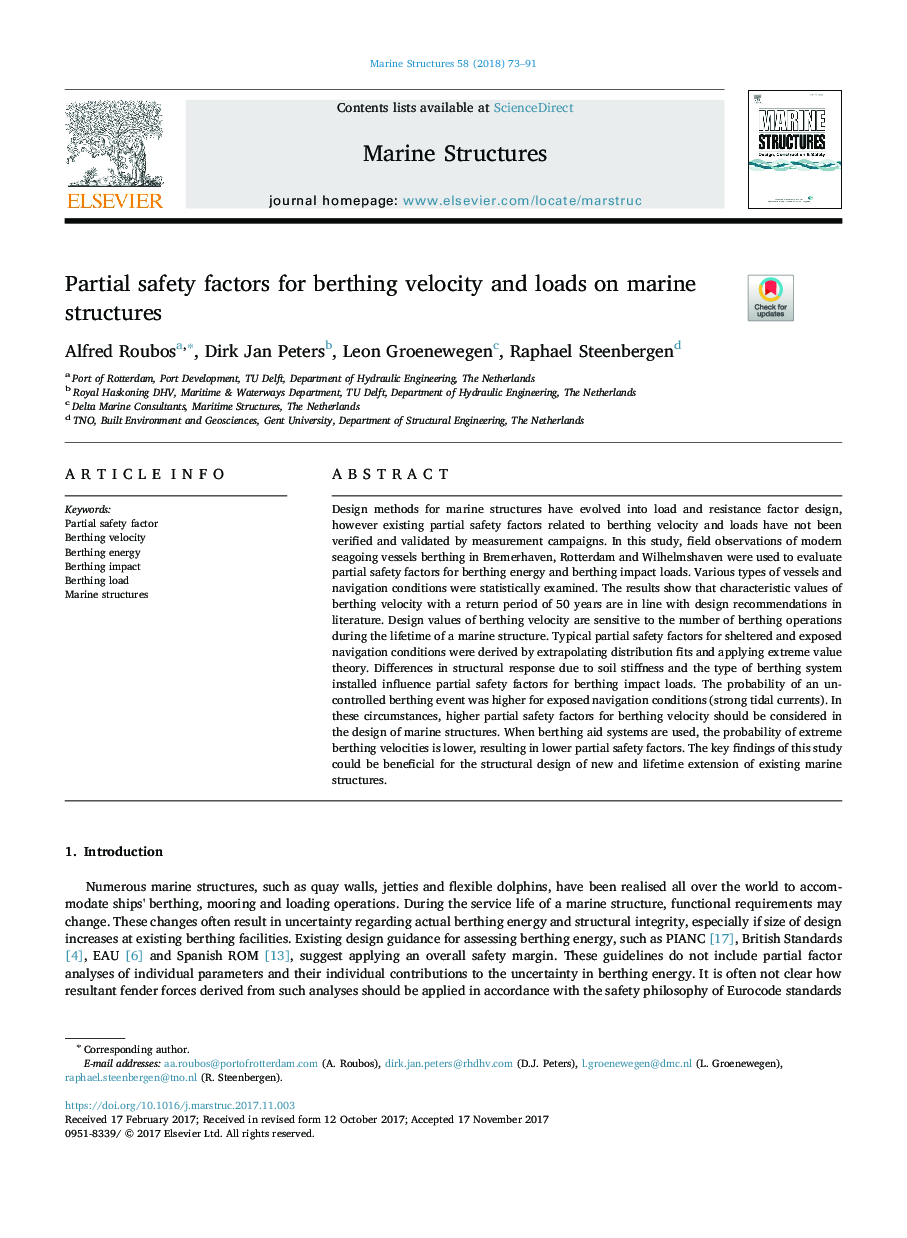| کد مقاله | کد نشریه | سال انتشار | مقاله انگلیسی | نسخه تمام متن |
|---|---|---|---|---|
| 6758042 | 1431213 | 2018 | 19 صفحه PDF | دانلود رایگان |
عنوان انگلیسی مقاله ISI
Partial safety factors for berthing velocity and loads on marine structures
ترجمه فارسی عنوان
عوامل ایمنی جزئی برای سرعت و بارگذاری بر روی سازه های دریایی
دانلود مقاله + سفارش ترجمه
دانلود مقاله ISI انگلیسی
رایگان برای ایرانیان
کلمات کلیدی
عامل ایمنی جزئی، سرعت پرچم، انرژی پرتگاه ضربه برشی، بار برشی، سازه های دریایی،
ترجمه چکیده
روش های طراحی سازه های دریایی به طراحی فاکتور بار و مقاومت تبدیل شده اند، با این حال عوامل ایمنی جزئی موجود در ارتباط با سرعت و بارگذاری چرخه، با استفاده از کمپنی های اندازه گیری تایید نشده اند. در این مطالعه، مشاهدات میدانی کشتی های دریایی مدرن در برمرهافون، روتردام و ویلهلمس هافن برای ارزیابی عوامل ایمنی جزئی برای بارگیری و تعویض بارها استفاده شده است. انواع مختلف عروق و شرایط ناوبری از نظر آماری بررسی شده است. نتایج نشان می دهد که مقادیر مشخصی سرعت بذر با دوره بازگشت 50 ساله مطابق با توصیه های طراحی در ادبیات است. مقادیر طراحی سرعت بطری در طول عمر یک ساختار دریایی حساس به تعداد عملیات قایقرانی است. عوامل ایمنی جزئی برای شرایط ناوبری سرپوشیده و در معرض انقباض توسط استخراج تناسب توزیع و استفاده از نظریه ارزش شدید بدست آمده است. تفاوت های واکنش ساختاری به علت سختی خاک و نوع سیستم پارکینگ تأثیر عوامل نفوذی نسبی برای بارهای ضربه کرنش. احتمال وقوع چرخه کنترل غیرقابل کنترل برای شرایط ناوبری در معرض (جریانهای شدید جزر و مدی) بیشتر بود. در این شرایط، عوامل ایمنی جزئی بیشتر برای سرعت باد سازی باید در طراحی سازه های دریایی مورد توجه قرار گیرد. در هنگام استفاده از سیستم های کمک به سوار شدن، احتمال کم شدن سرعت کمربند کمتری وجود دارد که منجر به کاهش عوامل ایمنی جزئی می شود. یافته های کلیدی این مطالعه می تواند برای طراحی ساختار جدید و عمر طولانی سازه های دریایی موجود مفید باشد.
موضوعات مرتبط
مهندسی و علوم پایه
سایر رشته های مهندسی
مهندسی عمران و سازه
چکیده انگلیسی
Design methods for marine structures have evolved into load and resistance factor design, however existing partial safety factors related to berthing velocity and loads have not been verified and validated by measurement campaigns. In this study, field observations of modern seagoing vessels berthing in Bremerhaven, Rotterdam and Wilhelmshaven were used to evaluate partial safety factors for berthing energy and berthing impact loads. Various types of vessels and navigation conditions were statistically examined. The results show that characteristic values of berthing velocity with a return period of 50 years are in line with design recommendations in literature. Design values of berthing velocity are sensitive to the number of berthing operations during the lifetime of a marine structure. Typical partial safety factors for sheltered and exposed navigation conditions were derived by extrapolating distribution fits and applying extreme value theory. Differences in structural response due to soil stiffness and the type of berthing system installed influence partial safety factors for berthing impact loads. The probability of an uncontrolled berthing event was higher for exposed navigation conditions (strong tidal currents). In these circumstances, higher partial safety factors for berthing velocity should be considered in the design of marine structures. When berthing aid systems are used, the probability of extreme berthing velocities is lower, resulting in lower partial safety factors. The key findings of this study could be beneficial for the structural design of new and lifetime extension of existing marine structures.
ناشر
Database: Elsevier - ScienceDirect (ساینس دایرکت)
Journal: Marine Structures - Volume 58, March 2018, Pages 73-91
Journal: Marine Structures - Volume 58, March 2018, Pages 73-91
نویسندگان
Alfred Roubos, Dirk Jan Peters, Leon Groenewegen, Raphael Steenbergen,
